Almost every cyclist has attempted to ride on their local bike path on a weekend morning – only to become frustrated with getting a poor-quality workout, due to having to maintain low speeds for safety reasons or to avoid less skilled individuals (or dogs) on the path. Alternatively, I’m sure many others have had the opportunity to ride with friends or family that aren’t of your abilities…again, potentially resulting in a non-ideal training session. There’s of course nothing wrong with enjoying a relaxing ride – and likely many of us should do more of those types of rides.
But still, as type-A athletes, you just wanna be able to ride in whatever zone or perceived effort level your prescribed workout is that day. Or maybe you just wanna throw down in a place you otherwise can’t.
Well, an Australian company might just have the answer for you – and I got to give it a whirl (literally). Meet AIRhub, a Bluetooth Smart connected front wheel hub that can dynamically apply resistance just like an indoor trainer would…except outside. Yup – it’s literally like taking an ERG trainer out on the open road. Mostly.
Here, let me explain.
What it is:
The AIRhub works by replacing your front wheel entirely. It’s kinda like when you buy a PowerTap wheel for your rear wheel hub, except this does far more than measure power – it actually applies force. Yes, in virtually every other cycling situation you’re trying to minimize drag (be it aerodynamic drag, road resistance, or even mis-aligned brakes). But in this case – you’re actually looking to add drag. Kinda like how some athletes train with parachutes or weight vests. Same-same, but different.
The AIRhub is created by Michael Freiburg, a world class cyclist himself with gold and silver Commonwealth Games medals to show for it. Oh, and the company is technically called Terrain Dynamics. Niftily appropriate name.
The hub is designed to apply a resistance load, which allows you to maintain a lower speed while increasing the power output required for you to maintain that speed. Meaning, let’s say you’re pushing 225w normally and going 20MPH/30KPH. That’s all great – but what if you’re riding with an equally weighty friend that can only push 185w and is thus going 17MPH? That friend won’t be with you for long, and will soon fall off the back.
But what the AIRhub does is to allow you to apply more resistance – yet (and thus) enabling you to slow down to match your friend’s speed while still getting the same workout. It does *not* contain a motor to make your friend go faster (or you go faster). It’s all about slowing you down.
The uses cases here are plentiful, and include:
A) Riding with friends/family that aren’t able to output your power
B) Riding in a peloton/group (within the draft) but still putting out the same power as the leaders
C) Riding on bike paths/etc where high speeds simply isn’t safe or viable
D) Riding downhill where you want to keep putting out power, maintaining effort
E) Simply adding resistance so that race day feels faster
I’m sure there are other scenarios – but those are the biggies.
The hub is made of carbon fiber, and contains an electric motor inside of it – effectively like a trainer such as a Wahoo KICKR. The unit is fully self-generating for power, so there’s no need to charge it or have any batteries. That’s great, though like the carbon fiber it does add to the manufacturing costs. The hub comes in at a weight of 1.5KG, though weight really isn’t a concern here – the whole point is slowing you down.
The edges of the hub include fins, which allow it to release energy as heat. After all, it’s sorta like one big brake. Which you may be wondering – why not just ride with your brakes on?
Well, as I’m sure anyone who has tried that knows – it’s actually rather annoying to hold your brakes on all the time. Additionally, it’s not as dynamic as this is. This is a little bit smarter and applies resistance in a number of manners, so it feels surprisingly natural. It doesn’t feel like you have the brakes on, but rather feels like what you thought was the flats is actually a slight incline.
Note that the previous version of the hub used to make a bunch of noise, but this new one is silent. I didn’t notice any noise at all from the hub while riding, though I was on fairly busy roads at peak evening traffic times. Also, the previous version used to have a 45KPH resistance ceiling (above that it couldn’t apply resistance), but that’s no longer the case. Just wanted to cover those two points for folks familiar with the initial version.
Hands-on Test:
While in Adelaide a few weeks ago for the Tour Down Under I got the chance to give the unit a quirk whirl out on the open road.
The first piece to understand is that there are actually five different modes on the AIRhub, all of which are configured via your smartphone:
A) Watts Mode: This means it adds X watts to your existing wattage level (i.e. add 50w).
B) Power Meter Mode: This will forcibly maintain a given power level (i.e. maintain 290w of resistance).
C) Heart Rate Mode: This allows you to specify a target heart rate, and it’ll add resistance dynamically to maintain that heart rate (i.e. maintain 150bpm).
D) CdA Mode: This adds resistance based on CdA, and thus the resistance will taper off depending on drag. For example, as you crest a hill and start descending it’ll add more resistance.
E) W/KMH Mode: This is similar to the first CdA mode, except that it’s linear, instead of using an exponential drag curve.
All of this is configured via the smartphone app, which uses Bluetooth Smart for connectivity to the AIRHub. However, one notable gap is that it can’t connect directly to an ANT+ power meter (for mode A above). This means you’ll need a Bluetooth Smart power meter, or a way to bridge the data. In the demo I was given, the founder was using a 4iiii Viiiiva ANT+ to Bluetooth Smart bridge (and HR sensor), which solves the problem nicely. Still, I’d much have preferred to see a dual ANT+/Bluetooth Smart setup.
You’ll pair these sensors within the app:
Speaking of that app – it is required to ride with the phone. You don’t have to have the phone on your front handlebars, but it does come with a Quadlock mount for doing so. Most others will probably just ride with it in their jersey pocket…which almost all of us do anyway.
The device acts like a treadmill – in that it does whatever you tell it to. In this case your controller is your smartphone versus a big ugly console in front of you.
With the basics all configured I set out to give it a whirl on the roads; in fact, specifically on the route of the People’s Choice event from a few days prior. This was handy as it includes a nice little hill to test things on going both up and down. Plus some flat sections.
I set the app to apply a specific resistance amount – in this case 100w. And from there I headed on out. Of course, with the resistance applied it just feels like I’m having to put out that given amount. It doesn’t feel unusual, but rather no different than going up a 2-3% incline.
You can configure the amount of applied resistance from 0-100w extra, in 1w increments. So if you were originally riding at 250w, you can get up to 350w of resistance on it. Or if you were at 400w, you can get up to 500w resistance on it, and so on.
Next, I shut off the resistance, and instantly I’d speed up – since I could now apply that additional resistance towards going faster, versus being slowed down. To shut off resistance you simply tap the little pause icon, and it pauses it.
It’s here where an ANT+ connection would have come in handy, because it could then likely have been controlled via Garmin Connect IQ and an app. No need then for any secondary device on your handlebars (or even with you).
I then played around with the maintaining resistance option (i.e. setting a given resistance level – such as 300w, as well as back and forth within different levels of resistance). All of which worked well enough.
What was striking to me though is just how smooth it felt. It ramped into the resistance versus being a hard brake. And accelerations felt normal too, it didn’t feel like someone was holding onto the brakes. Overall, I was impressed with the feel of it.
Is it worth it?
Of course, the tricky part here is the price: $1,950AUD (or about $1,482USD). Up to this point, they’ve been targeting higher end athletes (i.e. pros and training centers), but that’s rarely sustainable as a business model – especially in the smaller cycling realm. Still, for those athletes it likely works out well. And if I were willing to part with that much cash – I’d definitely pick one up.
But for me – the price has to be much cheaper. And I think it’d do fantastically well in the $500-$800 price range. Obviously, that’s a big gap to bridge, but it’s sorta the same challenge that Verve’s Infocrank had initially. It’s a solid product – but just needs a price adjustment to match what is likely significant demand.
For myself – I’d love to be able to add a pile of resistance and then do legit workouts on the various bike lanes near me – versus going further afield. Alternatively – it’d be awesome for The Girl and I to be able to do workouts together, side by side, and both be working at equivalent intensities. I’d pay for that privilege. It’s not just about tech at that point, but rather about spending time with someone.
How many hundreds of hours of riding did I put in alone on rides training for Ironman races, when The Girl was simply behind me a few miles? By tweaking resistance I could have slowed down speed-wise and maintained the same workout intensities as before. Thus presto: Matching her speed.
And that’s where I think the potential is. Sure – signing Olympic and Pro athletes is great, but as any company will tell you – they don’t pay the bills.
But I’m optimistic the AIRhub folks will figure out how to reduce the costs (and they do indeed have some ideas – such as changing some of the expensive materials they use like carbon fiber). And if they do – I’ll be first in line to buy it.
With that – thanks for reading!
FOUND THIS POST USEFUL? SUPPORT THE SITE!
Hopefully, you found this post useful. The website is really a labor of love, so please consider becoming a DC RAINMAKER Supporter. This gets you an ad-free experience, and access to our (mostly) bi-monthly behind-the-scenes video series of “Shed Talkin’”.
Support DCRainMaker - Shop on Amazon
Otherwise, perhaps consider using the below link if shopping on Amazon. As an Amazon Associate, I earn from qualifying purchases. It doesn’t cost you anything extra, but your purchases help support this website a lot. It could simply be buying toilet paper, or this pizza oven we use and love.

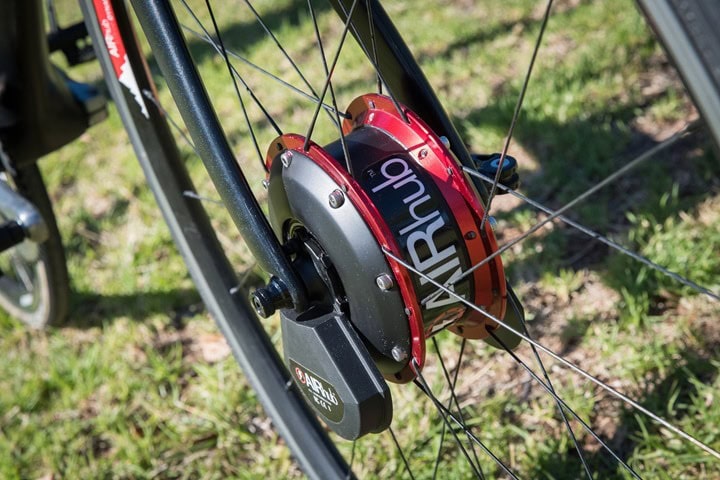
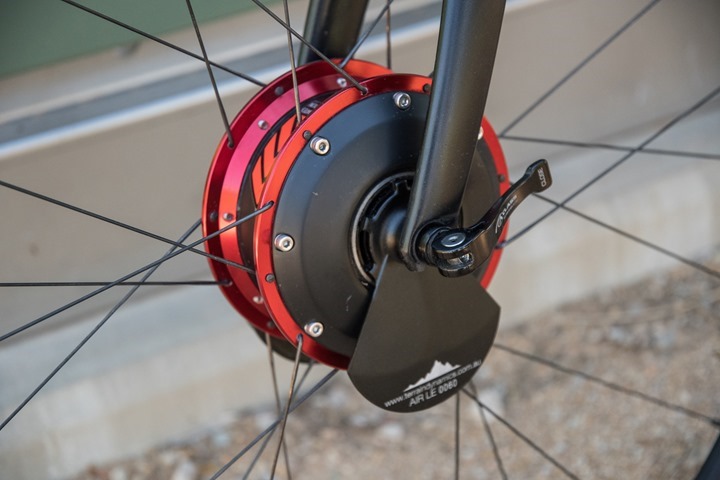
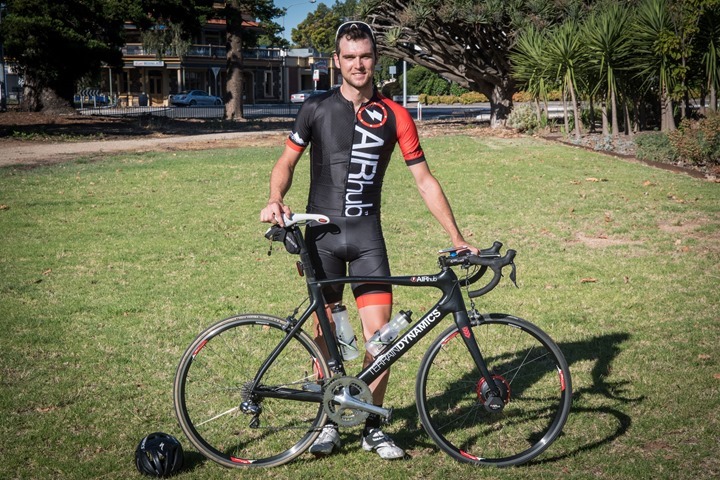
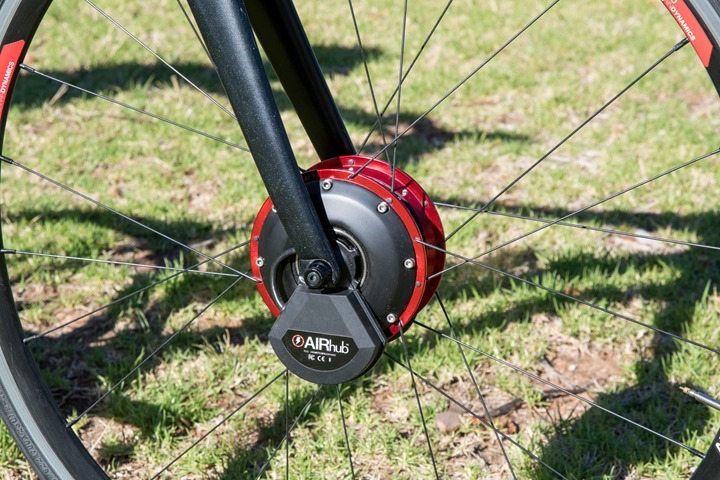
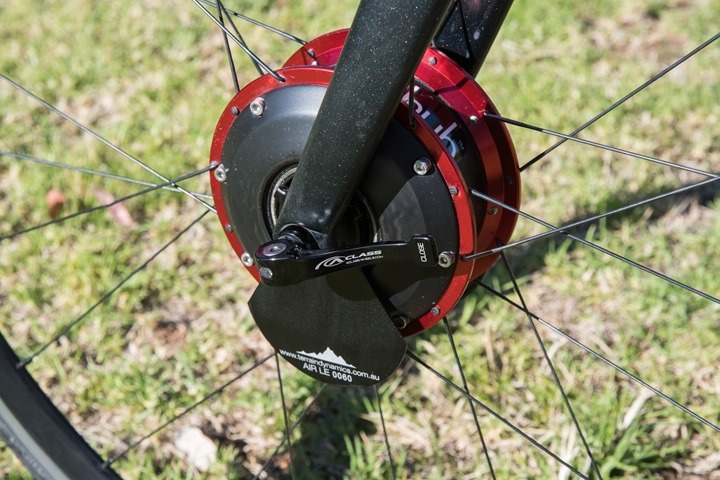

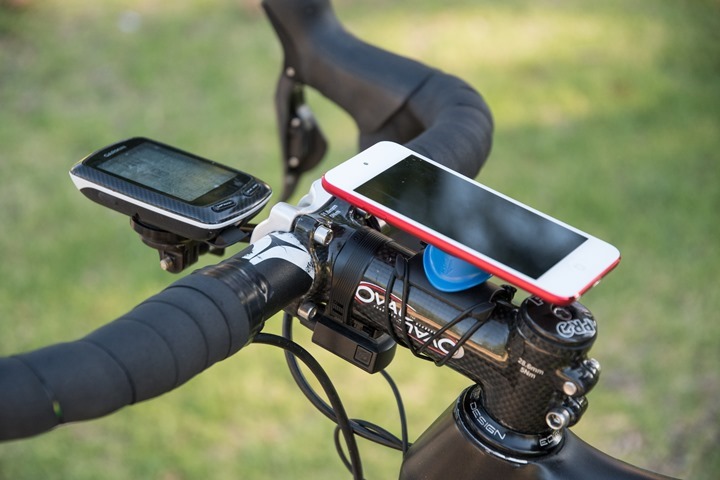
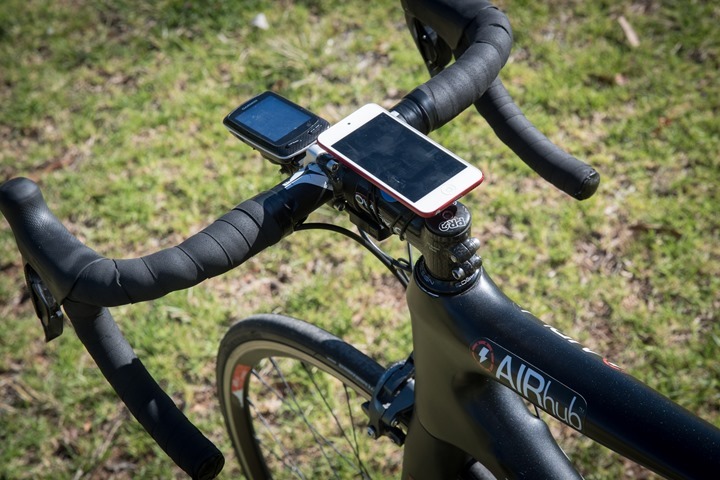
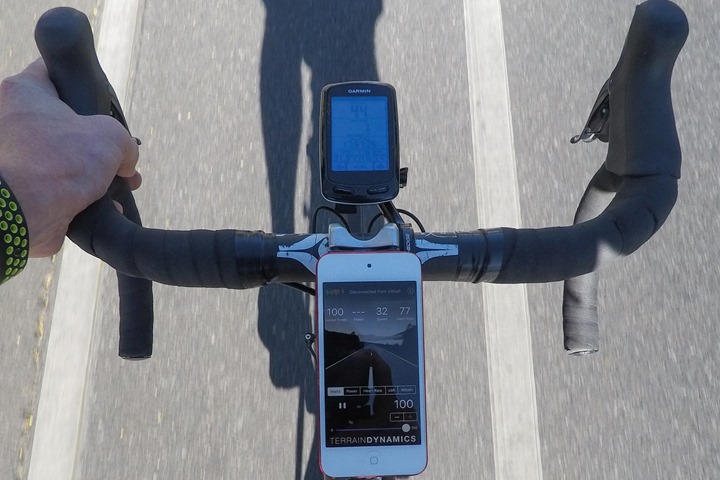

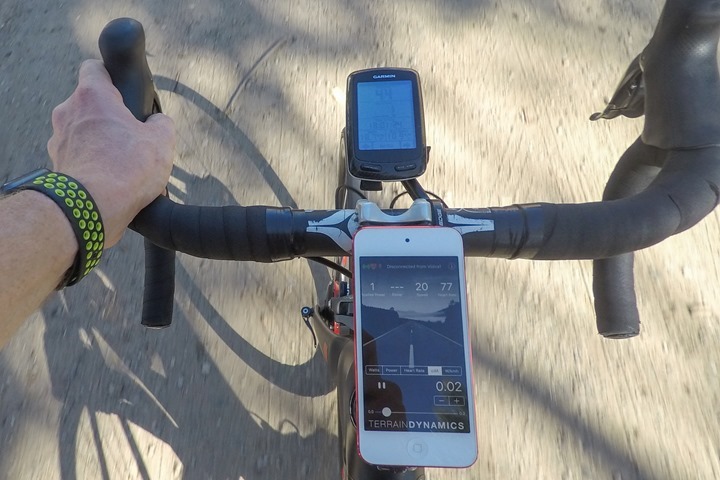
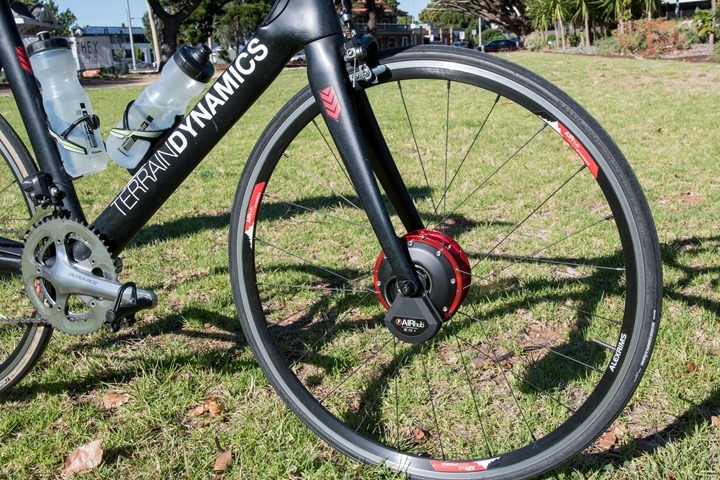
















I love riding with my wife on weekends, but when I’m training for something I simply can’t because of the output difference. I would really love to see this drop under $1000 because then it would be absolutely worth it for the quality time it brings with certain family and friends… while still giving me a workout without them glaring at me for having a HR <100
Or…just ride a fat bike…
All joking aside, an interesting idea. Maybe I could get my wife to ride with me this way.
Love it and agree on the price but is that suggested in US or Australian dollars?
With the other half there is a little benefit but with children you can be out for a couple of hours freewheeling and dawdling along. This would add at least let you get a steady resistance
This is both horrible and absolutely brilliant. :) Your own personal headwind.
I’m blown away by the ways that the cycling community continues to innovate year after year.
wow… ok I was interested until I saw the price. Could be good for training by just increasing the watts of a normal workout but not at 1.5k, maybe $500
For that first use case – riding with lower output friends/family – chances are you are riding with the same people frequently. And that their power output (but maybe not endurance) are consistently proportional to your own.
There are so many cheaper options for that case.
1) Ride a slower bike; mountain bike vs road bike.
2) Add higher rolling resistance tires
3) if we’re talking about kids, try a tag along bike.
4) Do what mismatched runners do – do intervals. The faster runner does a sprint ahead of the slower runner, and then back to the slower runner, and spends recovery time running at the slower runner’s pace.
I just don’t see the market for these expensive, special use case devices.
Then again, as I’m looking around to purchase a used bike, I don’t understand all of the $6000 used bikes on the market.
@Tyler: I’ve done all of those things (added lead shot to bike / worn a weight vest rather than 3) and it still wasn’t enough. 4 just manages to piss off the people I ride with, especially if they’re struggling up a hill and I just disappear before coming back for another go whilst they’re still dying on their arse.
However, the price is nuts. I’d rather buy my wife an e-bike (she doesn’t train). Hopefully it’ll come down though as it’s something I’d consider for sure, especially for rides with friends.
Agree that they are imperfect solutions.
I tend to treat my family rides as just that – leisure.
And get my workouts in separately.
1. If you already happen to have one or the desire to own one, It still doesn’t have programmable dynamics
2. It doesn’t add as much resistance as the Airhub does, again, not in a controlled fashion,
4. Only applies if intervals are appropriate to the session. If the session is a 5h tempo ride then that’s not possible.
Riders can outgrow their social circle. A mate of mine tagged along on an “easy” ride with myself and a couple of riders from a team I was guest riding with. He spent 40m in threshold HR on a 1:10 cruise. I’m from the origin town of the Airhub, one of the riders here uses it so he can come on a cafe recovery ride (and get a free coffee) at consistent/higher effort.
You forgot:
x. Adjust your brakes so that they’re rubbing. That’ll be a fairly constant application of resistance
I would LOVE to have to pedal downhill, and have some extra resistance on bike paths. I can say I would get use out of this, but would never be able to afford it at that price… Really cool idea though.
Great product. I don’t think it really needs carbon fiber though. The point is adding resistance, isn’t it. Weight is adding drag. Plain material, like aluminum or stainless steel would work too as long as it is tough and high quality. This should bring down cost. Just my thought. Oh, Ant+ should be on the list too.
Doing hills whilst living in a flat as a pancake area! (OK, but it’s still better than riding on rollers/turbo or riding hundred K’s just to do training)
Not many hills where I live, but plenty of wind.
The great thing about wind is that with a little look at super-local weather forecasts, you can plan a route with as much or little ‘downhill’ as you want.
I question the need to be a carbon fibre build, if we’re all about adding resistance just build it out of wrought iron. The price point is crazy, I’d just get a heavy bike instead and save the good one for race days/fun.
Ray, Can the AIRhub connect with Zwift, BKOOL or other trainer apps…a nice alternative for those having a non-electronic trainer. One device for both indoor & outdoor electronic resistance control. Assuming controls and max power/resistance are there, at a price point sub-$900 it would rely win share over Wahoo, Tacx, Cycleops and others.
This thing is on the front wheel, so you’ll need rollers for that. And I don’t think it is good idea to have resistance on the front wheel using rollers, or am I wrong?
Marius…you are correct…indeed one would need a roller. As far as front wheel resistance, as long as the change is “gradual” and not a big “step-change” it could work so one doesn’t go flying over. What do you think?
Can this be paired as a smart trainer in apps like trainerroad? I am thinking the only way this becomes useful is with the ability to do interval workouts to pre-set power output without manipulating an app.
I would also love this, mainly for the ability to ride with my wife and the local dealer ride while getting a meaningful training ride in.
I’m from Perth (where the Airhub is from), I’ve seen plenty around. The real use is for solid base and threshold work if you ask me.
I agree. Other than riding with your wife or other “slower” people, I can see myself doing intervals but there needs an app trainerroad like that controls that for me. Now I am doing the high effective trainerroad training outside. Do we know whether the app allows to that or whether it connects with apps like the wahoo app to control the resistance automatically depending on the interval? Price needs to come down below $1,000 though.
Darn. I thought this was a device that captured kinetic energy (like in a coil spring) as you slowed down to a stop, so that you could release it when you started off again. Does that exist or could somebody please make that? It would be awesome for commuter bikes! Anything that makes getting back up to just 10 mph would kick butt.
Very cool indeed…
I bought my wife a bike but we dont get out very often for this very reason. We’re (I’m) limited on training time as it is so I could getting great use out of this… Same goes with other cyclist buddies.
Like you, and most have noted, if it were less expensive I would be all over this.
I’ve been doing this for years…..it’s called a front BRAKE! And it is free! I use it when I ride with me wife and kids and want to get a real workout in. I also use it with my G3 Powertap wheel in the back and I want to maintain a certain wattage at low speed (like down a hill) for a long threshold interval on uneven terrain. Why would I pay $1500 for something I can do with my front brake. I am sure it would be more refined than my front brake solution….but for $1500 smackeroos? Seriously?
Because expensive rims wear away if you just mash the brakes on for a multi hour ride and heat them (oh and if their carbon that heat might full on explode your tires as well) and then cost $$$$ to replace?
Do you think someone is going to lace up a nice aero carbon rim on this hub? You could burn through multiple cheap aluminum front wheels and brake pads for the price of this hub.
I do acknowledge that you can’t really scrub speed with the front brake from aero position though
Think I’d rather buy an electric road bike for my girl to speed her up rather than to slow me down. I hate riding with add-on resistance from too soft tires, but I guess that would be the cheaper alternative.
(Just picking this comment at random)
I think one of the things that folks are missing when it comes to the line of thinking of ‘just ride a less efficient bike’ or ‘just have the other person ride an e-bike’, is that’s not really ideal training for some athletes.
For example, iron-distance triathletes really need saddle time in aero position – else you won’t be able to hold it for 5+ hours on race day. Thus, you need to be riding not just a triathlon/TT bike, but your TT bike. Position is so critical there, which is a core reason that iron-distance triathletes don’t tend to train on even road bikes during the season.
Haha, funny, this is exactly what I’ve been thinking for about a month during Trainerroad rides :D Such a brake would allow to have well manageable workouts also outside!
Nice to see that someone has made it real – and hopefully the cost can and will be driven down to make this a success :)
Bluetooth Smart came to the Fenix 5 any idea if it’ll show up in Garmin Head units as well?
If I’m not mistaken for the moment bluetooth is only supported for heart rate monitors for the moment in the Fenix 5
Hi Ray, thanks for this “hands on” article. I have a doubt. By increasing the resistance in the front wheel, in some escenarios, increases the risk of falling from the bike to the front?
Here’s me taking a corner with no hands with 100W applied by the AIRhub. Answer, no. link to youtu.be
(Y) looks great, thanks Shane.
Get it down around the price of dual leg power meters, ie $6-800 and I would be very interested!
Great idea. Anyone who’s ever tried to drag the brakes on a downhill mid-interval to maintain power knows how poorly that works and how hard it is to control. I love the idea also of being able to do 20 or 30 minute “climbs” on the local flat roads. Too pricey though.
+1 for ANT+ control on the head unit, and wouldn’t mind if the energy from the hub was harnessed to recharge all the electronic devices on the bike.
But *Yikes*, about choked on the price as others did – mid $500 seems more viable.
Ray, I love this site so much, but please stop using the word “literally.”
That is your comment? Does it literally bother you?
He’s literally only used it twice in this article
No I don’t see it working,
I often ride my old Mnt bike on the road, and while I don’t play with watts, I know I’m working hard… but all my friends always want to know what my ave speed was, what my strava splits were. So on a ride if I fight the wind or ride my old bike, of fitted one of these to the road bike… No one would care, but me! And the cyclists I know want to be the guy who wins… and I’m not talking races, I’m talking training rides.
Maybe my friends are different to yours. oh and if I want to ride with my wife and work harder than her, I take the tandem!
The other obvious use is rollers. To simulate riding into a headwind add 50-100 watts. Tons of uses, pre race warm ups, winter roller sessions etc.
I bought one (live in Australia) simply to provide resistance when I ride with my teenage children or weaker riders as part of my triathlon group as well as to keep the resistance up when I ride. You can now make your own hills when it is flat. I agree its expensive, but for the added safety of going a bit slower it is well worth the investment. Everybody needs to weight up cost vs benefit. It simply gives me another mechanism of getting some good training sessions in my limited time schedule. It also come with a heart rate monitor from 4iiii. Apart from the price being an issue, I would highly recommend it. For me it came down to safety, being social and getting a good work out during training session.
I just finished reading Chris Froome’s autobiography and he talks about how he would constantly drag his brakes on decents in order to maintain a 250 watt average for his rides.
You can certainly see why the pro’s would love this.
Woa!
Awesome product, would indeed definitely buy if it was a little cheaper, in the 600-800 dollar range.
The social troubles I could evade by just using this think would be tremendous..
Strava would be a little bit less interesting, but I would definitely have a lot more pleasure riding along with people I would otherwise avoid for doing quality trainings..
So, this is kinda like a front disc brake ?
What about the fork ? It’s gonna be under some mechanical stress in a place it wasn’t designed for.
Am I the only one concerned about this ?
like the idea but not the price. there are cheaper options like using wider tires, lower air-pressure (or a mountain bike).
Thanks for reviewing this Ray – it’s really interesting and pretty cool. Absolutely agreed that the prime use case would be for someone who wants to ride with others but can’t get a decent workout if they do because of a (in my case) 30-100w difference in power outputs.
I’d buy it in a flash just for that BUT, not until they go dual bluetooth and ANT+ (or just ANT+).
While my phone might travel in my pocket on a ride it’s not getting added to the Garmin up front and I can’t see that this is that useful unless it can be adjusted on the fly as conditions dictate. Hell, I’d even buy the 4iiii bridge thing so it could talk to my power meter but I’m just not dealing with the phone + garmin up-front.
Would totally buy if cheaper. Great for riding with my wife…at the moment the only way to equalize us is for me to pull the kids in a bike trailer.
Mountain bike with wide ass tires just is not enough.
Great idea
Hopefully it’s patented and this guy can sell or liscence to the big guys like powertwp, Garmin, mavic to get price down
I have a suggestion for the makers of this (Terrain Dynamics):
Put it in the rear wheel and add a hub-based power meter (a la Powertap). This would solve the bridge from power meter to 4iii to phone to air Hub. All one unit. Also, if the price could still be in the same ballpark, $1500, then you are selling a solid training wheel with a power meter, with the added functionality of increasing resistance. Unless for some reason it is not technically feasible to go in the rear wheel, that concept could be a real industry game-changer.
Thoughts?
I could see this being useful for cold weather training as well. Unless you got the layers dialled in perfectly speeding up results in too much draft cooling me down even more. I then sometimes hit the brakes a bit so I can actually get warmer.
has anyone tried a trash bag parachute or something? there has to be some cheapo bodge that sort of gets you extra resistance without breaking the bank
That sounds scary if it’s windy!
The great advantage of this device is that you could have a varied level of resistance (ie. off during the ride to the main venue, varying intensities/intervals for you, while the kids/wife pootle alongside you comfortably). Using a heavy bike or MTB tyres or wearing a parachute (!) would be permanent resistance. Much less useful, albeit cheap/free.
This product would solve my problem with my better half on slower bike. I see 2 dealbrakers:
* price
* fact that I cannot connect my Suunto Ambit3 watches to my PT G3 hub while using AIRhub
It would be nice if AIRhub can conect to wattmeter by ANT+ and than to phone by BLE.
forget trash bag, apparently for $10 you can get a real parachute that worked for Alejandro Valverde of Movistar
link to aliexpress.com
The problem though is that’s not realistic. Sure, it makes for a good PR story that a team puts out – but for actual riders on real roads without an support vehicle? No.
The mere act of a car going by at speed will send the parachute flying around, likely straight into the wheel of the rider – likely causing all sorts of bad.
Sure, if you’ve got roads you control (with support vehicles) or are otherwise 100% empty, it’d probably be fine. But none of us actually train that way.
(As an aside – it might make for a fun video to show why this doesn’t work…and oddly enough, I do have one of those parachutes.)
Bring on TrainerRoad Control and no one will be doing in ERG sessions in the summer.
I love the application, less the price but am mostly concerned about the idea of applying resistance to the front wheel…esp. in turns…esp. in rainy conditions, esp. going down hill…then again you can disconnect it…but then it is no longer a seemless experience… Any thoughts on this?
Very cool, but at that price there are so many alternative ways to achieve what it sets out to do! Combine that with only being able to control it via your phone, it’s a double whammy.
Great to see innovation, but I doubt we’ll see much uptake professionally or amateur.
They do have about 8-10 pros using it already, so there’s clearly some interest there.
I see a fantastic marketing opportunity being missed here.
If this device can generate friction based on computed cda or wattage, then it should be able to diplat these data.
This would instantly become the first portable mini wind tunnel that can compute accurate cda and wattage base on drag at the wheel ( not aero data from a pitot tube like other products ). The added drag from the hub could be software deducted from the computed cda.
Imagine that you could instantly see the effect of your position and equipment change on your cda, live. In real road conditions. Not wind tunnel lab conditions. This could potentially become the hottest product of the year for triathlon and TT enthusiasts and professionals. I would buy that thing in a heart beat. Even at the current price.
My understanding of CdA mode is that it vary resistande depending on square of your speed. So I cannot be used to measure CdA.
Sounds like a great idea, would consider it in the $500 range for occasional use, can’t afford to spend their current asking price on such a once-in-a-while item.
Love the innovation though, thumbs up!
Mmh, it reminds of something Danish pro-cyclist Ole Ritter once said in an interview; roughly this…
“It is odd with all these riders [that would be us], training on bikes much more lightweight than when I rode races. In my days when we trained we put led in our pockets and water bottles to get the weight up.”
Of course, when the rest of us ride, it is not necessarily for the training but just as much for the thrill of the speed and the sound of carbon on the morning asphalt. That doesn’t make this quote any less fun, though.
*yawn*…another solution to a problem that doesn’t exist.
If you want to increase resistance on the road simply ride a $600 MTB with big fat knobbly tyres.
Job done.
Simplez.
This is not solution for everyone. E.g. I ride pretty fast, expensive and uncommon racing recumbent. It is not possible to buy the bike with same geometry what would be much slower. It is possible to buy slower bike with sort of geometry but it is still pretty expensive. And still to fast for riding with my better half. And I don’t have space in our small flat for another bike.
Where’s the USB port so I can charge the phone and garmin while riding?
Wouldn’t this cause a possible problem on sharp turns as the resistance it supplies could cause the grip of the tire to fail?
What happens if you put it on backwards?
1)infinite energy
2)
3)
4) profit…
I may be misunderstanding how it works but can this product also measure direct power (can it replace a standart powermeter). If yes, I would gladly pay the price as I don’t have a powermeter yet, but I’m planning to get one soon + I would have the controllable resistance feature !
If not, then I still think it’s a nice product and would certainly buy it for 500-600$ to train while riding with my wife and kid !
I definitely see the utility of this, having lived in Chicago where most competitive cyclists in the city do their weekday training on the Lakefront Path. When its cool out or the weather is bad, it’s a decent place to train, but when the sun is out, the crowds come out, too. I would often ride my MTB on my nice-day training rides to slow myself down (and ride the grass/gravel side path if necessary).
Also, going for rides with my wife, who doesn’t train, would be a lot more fun for both of us.
So – the constant power mode presumably requires a power meter to be already installed on the bike? Now we’re talking $$. On the other hand, it’d be cool to have trainer-style ERG workouts with ‘super realistic VR’!
If I am that desperate to add resistance to my rides I can just let some, or more air out of my tires. Will it be precise? No. Will I be able to measure wattage on my crank arm based powermeter? Maybe, just maybe. Can I take the $$$ I saved and buy my lover a gift I know she’ll love? Absolutely and I will avoid the shame of being the butt of so many jokes….
Our LBS shop team had every level from a Cat 1 to Cat 5s, & even a few MTB’ers. We’d TRY to do an occasional whole team ride but with the varying levels it would really end up being two or three separate rides, kind of like A, B, & C club rides. Everyone riding together made the various weekend business park crits/CX races better as you actually knew the guy/gal racing in the same kit either before/after your race.
This would be great for the Cat 1’s & 2’s to be able to ride with the slower guys & still get a workout in.
I can’t be the only one that laughed out loud when I read the first few lines, almost became convinced of this products usefulness, then laughed harder when I saw the price. ?
Brilliant, but I’m pretty sure my price point wouldn’t be higher than $500, even with addition of ANT+. I suspect that won’t happen for several years and would require a new market entrant to put some downward pressure on TD’s pricing model, in addition to increased demand. But cheaper/heavier materials seem to be a no-brainer to me. I’d put my money on this being the primary front wheel of precisely zero people. The whole point is inefficiency. Go for it, guys – bring the price down, watch your demand curve shift, and give us all a reason to rationalize spending even more money on an already ridiculously expensive hobby.
If I understand correctly, the device is constantly providing a braking load at the front wheel. This is ideal for it’s intended purpose, but my concern would be how it affects handling, balance, and front and rear tire grip near the limits of traction. Clearly, if some of the grip is being used for braking, less grip is available for cornering. This is true with good pavement, but its effect may even more surprising with a contaminated surface (e.g., water, sand, snow, ice).
Is there a big potential safety issue here?
Perhaps STAC Zero magnets could be a cheaper solution for the average Joe.
How much brake force (or torque) can it apply??
Or differently put what grades can be simulated on flat road for, say, 75kg rider?
Found some in the RTFM thing…
0W to 100W braking is possible (to set with the controlling app).
Braking is only active when speed is above 15km/h
(however need to get above 20km/h for it to kick in initially).
But no clear statements on if you really can get 100W at 15km/h.
So with some physics/math that would be a brake force of max 24N.
And brake torque for a 700wheel/622rim of ~max 80Nm. But that might be smaller.
In fact I hope it is since there appear to be no (I can’t find anything at least) extra measures to make sure that the axle will not start rotating in the fork. 80Nm and a normal quick-release mount looks scary to me.
So the 100W might only be available at higher speeds…
Have anyone tried the bionx ebike 4-level regeneration as a training tool?
OOOops, got the torque numbers wrong…
Torque should be max 8.4Nm, that should be more in line of a quick release mount.
Good!
Anyway, what I would have done:
1) Build the thing as a Brake-Trailer. Use parts mainly from mass produced ebike kits, just need some extra processing and BTLE things to control it.
2) invent the sport of bike-pulling (but someone should already have done this – or at least claim it…)
3) start building bikes with very interesting wheels and gear ratios
£500 and I’d get one. Turns rides with the missus in proper training. Great product, just price is a bit silly at the moment.
Maybe some new player and come in and corner the consumer market. Someone Kickstart this pronto.
As someone with a wife who also enjoys training but is a decent amount slower than me on the bike, I love the idea of this for the occasional long ride together! Unfortunately I’m poor and the price is way out of my range, but I think I see a solution. For those like me who would really only use it once every week or two, I think we would definitely drop $10-$15 per long ride to rent one. I wonder if these things are durable enough for a LBS to make money on a rental business? It would be stupidly easy to drop by the LBS at the beginning of my ride, swap out the front wheel, then drop by again at the end of my ride to swap back.
To ride with your better half, without losing him/her and still have lots of fun, good training and conversation, buy a road or mountainbiketandem. Can also be ridden with kids behind. And if you really want to train, let the weaker one, do even less! ;-)
But remember that wherever your relationship is going, a tandem will get you there faster!
Thanks for your review of the Airhub I just want to know what it felt like for cornering downhill and also when you are travelling uphill.
Make it ANT+ & Garmin controllable & I would get one in a minute.
I bought one. I have mixed feeling about it. Problem is that even with outside temperature at 17 degree Celsius, it heats up very quickly to above 110Deg which triggers a reduction of the braking power. If I stop for 15min to let the brake cool down, then start using it applying 100W, I would reach 110deg after 5min, and the braking power will decrease. After 5min, I would have only around 55-60watts left as max braking power, and then it would stabilize around these values. Ray, I am not sure if you had a similar experience, but that would seriously limit the interest for me as my friends have an average power which is >90watts lower than mine.
Also, it cannot really help equalizing power between 2 riders on real (steep) climbs, since the brake needs 20km/h to switch on, and then it switch off if speed goes below 15km/hr.
Great Tests!